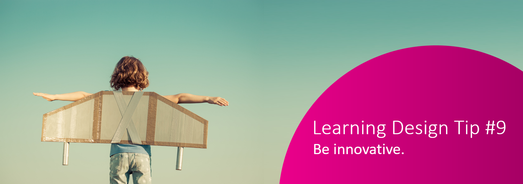The only constant in the world … is change. Innovation is both a driver of change, and a response to it. It’s an important skill and mindset for any learning designer. It’s not about chasing the latest shiny new toy, or constantly pushing the boundaries on risky projects. It is about identifying emerging trends and matching them with appropriate projects. It may sound counter-intuitive, but the future of work requires that innovation becomes mainstream.
‘But I’m not innovative!’ Then learn! Here’s how the easyA team stay innovative:
Get physical
If you’re stuck with coming up with a learning design for a particular piece of content, take some old Latin advice – solvitur ambulando – it is solved by walking. Take a break from what you’re doing and head outside – your brain will continue to work on the challenge in the background and the change of setting may unlock those new ideas.
When you’re having a discussion or meeting about a design, stand up. Not only will your standing meeting generally be faster than a sit-down one, the change in perspective may spark new approaches.
Squeeze a ball in your left hand. This stimulates neural activity in the right (creative) side of your brain.
Get social
When you’re designing, having a deep understanding of your end-users will help you to consider how you can best meet their needs. Start with basic demographics, but don’t stay there – find out their pain points, get personal with some qualitative, ethnographic research. Talk to people.
Surround yourself with innovative people, not just in your immediate circle of colleagues, but get to know the other innovators within your organisation, and beyond it – make sure your learning network includes innovators in the fields of learning design and ‘nearby’ professions, and include some far-flung innovators in the mix as well.
But don’t just have a general network of innovative people. Be specific for your projects – identify and buddy up with a particular person who can give you feedback and provide a bouncing board for ideas.
Get cultural
Innovation in design doesn’t happen in a vacuum. Your organisation needs to invest in innovation through allowing time and budget, and through providing rewards, incentives and resources.
How you and your organisation respond to failure is also important. If it’s not safe to fail (and learn), then it’s not safe to innovate and experiment.
Have some fun. A positive affective environment is much more conducive to innovation.
Get a new perspective
To break out of the usual ways of thinking and designing, look at your project through some different ‘lenses’ – there’s the tried and trusted ‘blue-sky’ thinking where you consider what the design could be if there were unlimited resources at your fingertips. You could consider how the design might change if you changed your primary audience, or if your main design tool suddenly was unavailable, or the LMS didn’t exist.
Try some constraints – if you had to finish the design in half the time, or with only 20% of the budget, or with less than 50% of the word count – how would that change things?
What would X do? From mild (your team manager, CFO, intern) to wild (your barista, favourite fictional character, global-thought-leader), a different perspective can help you to think outside that proverbial (and let’s be honest, a little cliched) box.
Sometimes innovative ideas build from what others are doing. Start an innovation file where you keep examples of new ideas, creative approaches, examples of where people have broken the mould – colour combinations, design layouts, interactions, phrasing, blended approaches – if it catches your attention, keep a copy of it. When you’re in need of inspiration, pull the file out and use it as a springboard to new ideas.
As you shift into innovation being just a regular part of your design processes, you’ll position yourself and your learning designs as both handling the future, and creating it.
Interested in a deep dive?
- Dr. Amantha Imber gives some scientifically-proven tips that’ll help you get creative.
- Not convinced about the left-hand ball squeezing? Check out this article from Psychology Today.
- Those Latin speakers had it right about walking, Stanford research proves it!
- To stand or sit in meetings? Join The Conversation and make up your own mind.
What will you do?
Which of the ideas in this post can you try in the next week?
Get it touch!
Contact us at easyA to explore how our learning solutions design team can work with your organisation: www.easyauthoring.com

